When President Trump defended the “very fine” people among the white supremacists who terrorized Charlottesville, Virginia, on Tuesday, his new executive order on infrastructure announced moments earlier went largely unnoticed.The sweeping order aims to deregulate and speed up construction of federal infrastructure on a grand scale, but a hidden provision revokes yet another environmental protection — this one designed to prevent flooding. The rule mandated that all federally funded infrastructure projects at least consider rising sea levels due to climate change. While eliminating that may shorten the time needed to build, say, a highway, the decision could end up costing taxpayers more in the long run and disproportionately harm poor communities and communities of color.Flooding has become one of the most widespread and costly natural disasters in the U.S., according to the Federal Emergency Management Agency (FEMA). For example: After the devastating flooding caused by Hurricane Sandy in 2012, President BarackObama issued an executive order that updated the Federal Flood Risk Management Standard to require that all federally funded projects in flood-prone areas build at least two feet above future projected flood levels due to climate change.Trump’s executive order, “Establishing Discipline and Accountability in the Environmental Review and Permitting Process for Infrastructure,” reverses that. The new policy essentially streamlines the process of obtaining permits to build critical infrastructure like highways, public schools, and hospitals.That directly aligns with his earlier infrastructure plan’s promise to “dramatically reduce permitting time for these infrastructure projects from 10 years to 2 years and to get a ‘yes’ or ‘no’ quickly by slashing regulations.” And it’s precisely regulations aimed at helping communities become more resilient, like the Federal Flood Risk Management Standards, that are being cut.Eli Lehrer, president of the R Street Institute, a conservative think tank focused on climate change, told Bloomberg that rescinding the regulation is a “fiscally irresponsible decision that is a disaster for taxpayers.”But it’s not just taxpayers’ money at stake. Like the dozens of other environmental regulations being rolled back, lowering flood-preparedness standards “has real implications for communities that depend on infrastructure for their well-being and livelihood,” said Rachel Cleetus, lead economist and climate policy manager at the Union for Concerned Scientists.Of all the places around the coast that face the prospect of chronic flooding in the next 20 years, “a disproportionate number of them are also home to socially and economically vulnerable communities,” Cleetus added, according to her research on coastal flooding projections.Study after study has shown that poor communities of color are disproportionately affected by climate change, especially flooding. They’re more likely to live in floodplains and flood-prone areas and be more dependent on public infrastructure. They’re also less likely to have access to resources to deal with flooding, according to Neenah Estrella-Luna, a former law and policy professor at Northeastern University. For example, while flooding following Hurricane Katrina affected the entire city, socioeconomic class and race served as a strong predictor of people’s ability to cope and to recover.Trump’s executive order may achieve his campaign promise of speeding up the process for building federally funded infrastructure. But slashing efforts to make infrastructure more resilient to flooding could end up bringing harm faster to those already most affected by such disasters
After the devastating flooding caused by Hurricane Sandy in 2012, President BarackObama issued an executive order that updated the Federal Flood Risk Management Standard to require that all federally funded projects in flood-prone areas build at least two feet above future projected flood levels due to climate change.Trump’s executive order, “Establishing Discipline and Accountability in the Environmental Review and Permitting Process for Infrastructure,” reverses that. The new policy essentially streamlines the process of obtaining permits to build critical infrastructure like highways, public schools, and hospitals.That directly aligns with his earlier infrastructure plan’s promise to “dramatically reduce permitting time for these infrastructure projects from 10 years to 2 years and to get a ‘yes’ or ‘no’ quickly by slashing regulations.” And it’s precisely regulations aimed at helping communities become more resilient, like the Federal Flood Risk Management Standards, that are being cut.Eli Lehrer, president of the R Street Institute, a conservative think tank focused on climate change, told Bloomberg that rescinding the regulation is a “fiscally irresponsible decision that is a disaster for taxpayers.”But it’s not just taxpayers’ money at stake. Like the dozens of other environmental regulations being rolled back, lowering flood-preparedness standards “has real implications for communities that depend on infrastructure for their well-being and livelihood,” said Rachel Cleetus, lead economist and climate policy manager at the Union for Concerned Scientists.Of all the places around the coast that face the prospect of chronic flooding in the next 20 years, “a disproportionate number of them are also home to socially and economically vulnerable communities,” Cleetus added, according to her research on coastal flooding projections.Study after study has shown that poor communities of color are disproportionately affected by climate change, especially flooding. They’re more likely to live in floodplains and flood-prone areas and be more dependent on public infrastructure. They’re also less likely to have access to resources to deal with flooding, according to Neenah Estrella-Luna, a former law and policy professor at Northeastern University. For example, while flooding following Hurricane Katrina affected the entire city, socioeconomic class and race served as a strong predictor of people’s ability to cope and to recover.Trump’s executive order may achieve his campaign promise of speeding up the process for building federally funded infrastructure. But slashing efforts to make infrastructure more resilient to flooding could end up bringing harm faster to those already most affected by such disasters
Advertisement
- The United States suffered more than $260 billion in flood-related damages between 1980 and 2013, more than any other natural hazard.
- On average, more people die annually from flooding than from any other natural hazard.
- Flooding accounts for approximately 85 percent of all disaster declarations.

Advertisement
